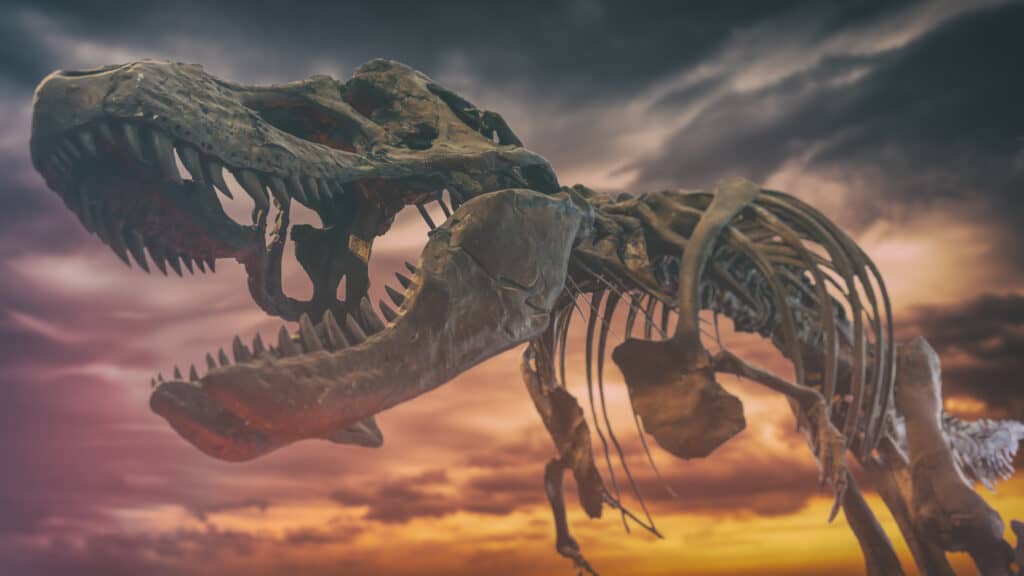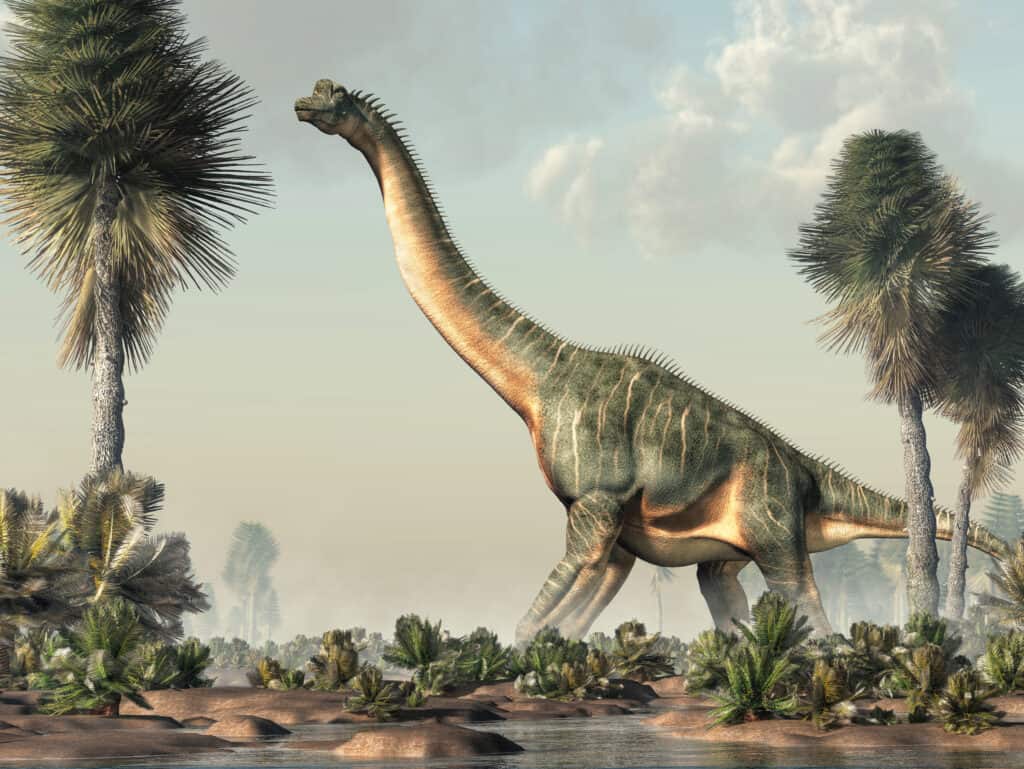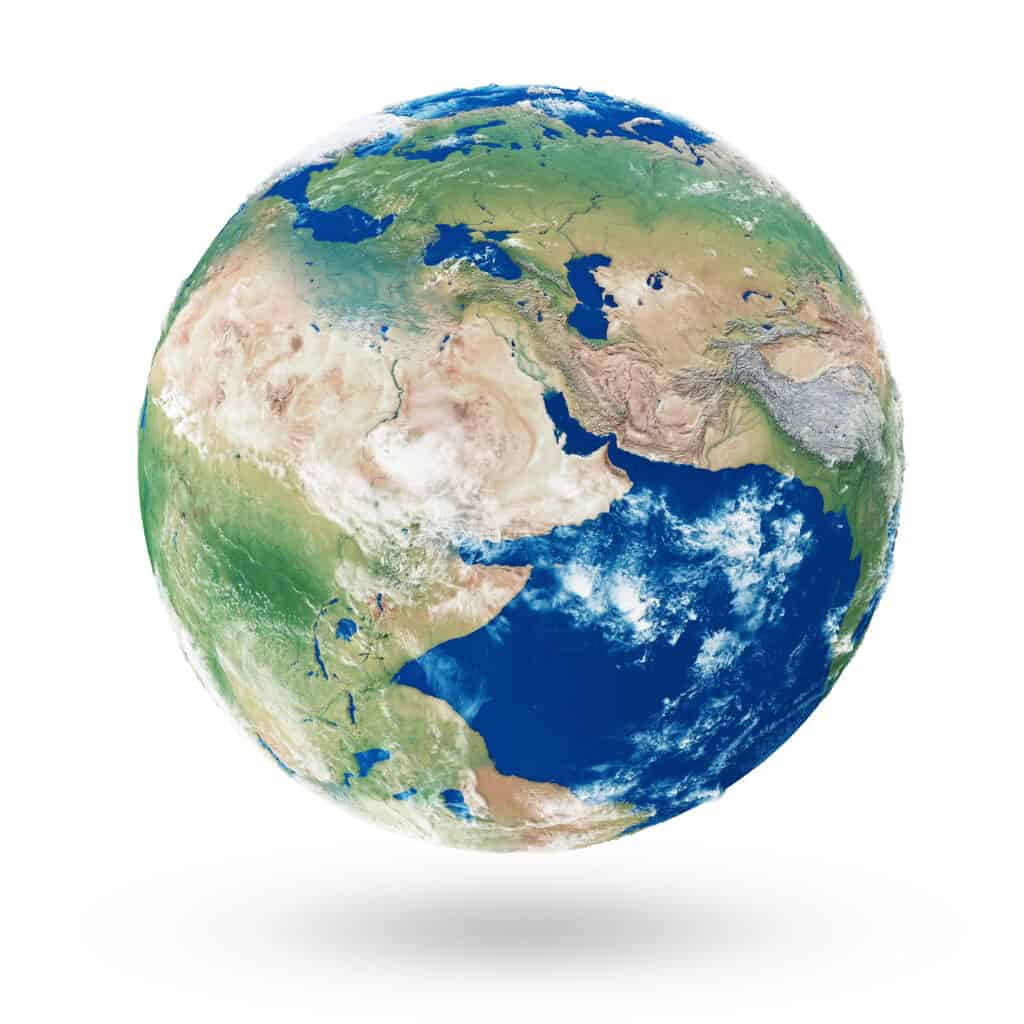Key Points:
- Approximately 66 million years ago, during the Cretaceous period, many invertebrates and vertebrates became extinct. Known as the K-Pg extinction event, scientists believe that a 6-mile wide asteroid hit the earth, causing a string of events that killed off all large creatures.
- The Cretaceous period is knows for the dinosaurs that populated the lands and oceans. The dinosaurs that had mammalian traits continued to exist and evolve after the other ones became extinct.
- Animals like astropods, snakes, crocodilians, lizards, mammals, and amphibians made it through the extinction event that killed off the dinosaurs.
The Age of Dinosaurs ended with the Cretaceous period. Even so, new dinosaurs still appeared during this time. The first pachycephalosaurs and ceratopsian dinosaurs appeared during this period. The fossils of the first flowering plants, insects, modern birds, and modern mammals are from this time.
What are the important things that you should know about the Cretaceous period? Let us study the following information and understand the major events, animals, as well as the duration of this significant period.
Major Events
The Cretaceous period is known for the K-Pg extinction event. This event happened approximately 66 million years ago. During this time, many invertebrates and large vertebrates became extinct. There were consequences to this biological, geological, and climatic event. Below are the significant events of this period.
The K-Pg (Cretaceous-Paleogene) Extinction Event
Scientists called it the K-Pg extinction event because it happened between the Cretaceous and Paleogene Periods. It was formerly called the Cretaceous-Tertiary or K-T event. The experts discovered evidence of a blast impact from an asteroid that was 10 kilometers or six miles across. The asteroid’s impact caused massive tsunamis and shockwaves. It also triggered a large cloud of dust and hot rock into the Earth’s atmosphere. The extremely hot sediments fell back to the Earth and started fires. These events increased the planet’s atmosphere further.
The tremendous heat cooked animals alive, especially those that were too large to find a place to hide. Small animals were able to hide in large tree trunks, underground, in caves, or underwater. They may have survived the first blast of heat. Particles of dust and debris stayed in the atmosphere. These blocked the sunlight that animals and plants needed. The reduced amount of sunlight led to the lowering of the planet’s temperature. This might have debilitated the large animals that needed high amounts of energy.
Smaller land animals that ate plants and other animals survived as scavengers of decaying plants, roots, dead dinosaurs, and fungi. These were birds, lizards, mammals, or archelon turtles. These small animals had low metabolic rates, which allowed them to wait out the disaster. Scientists believe that massive volcanic eruptions at the Deccan traps between Asia and India happened before the K-Pg event. This might have contributed to the mass extinction.

The tremendous heat of the K-Pg (Cretaceous-Paleogene) Extinction Event cooked many animals alive.
©Atomazul/Shutterstock.com
The Cretaceous Climate
The planet was warmer during this time. Many fossils of tropical animals and plants are evidence of this. Nuclear winter happened when the asteroid hit the Earth. The suspended particles in the atmosphere led to a great drop in temperature.
The Cretaceous period brought about the first diversification and appearance of flowering plants. Different organisms, such as insects, evolved as they took advantage of new food sources that these new plants gave them. Cycads, seed ferns, and ginkgos were replaced by conifers. Sea life continued to bloom. It became even more diverse.
The Rudist mollusks created brand-new coral reefs. The Tyrannosaurus rex emerged as the largest land predator. The Quetzalcoatlus was the largest flying organism. Reptiles reigned.
The Animals
Dinosaurs were the most numerous animals during the Cretaceous period. Among them, certain groups became more dominant than the others. Sauropods filled the southern parts of the planet. They were rare in the northern continents.
Antarctica was filled with Ornithischians, such as the Iguanodon, that stayed in herds. Towards this period’s end, large groups of Triceratops fed on low-growing plants and cycads in the north. The T-rex dominated with them. The Spinosaurus was the great meat-eaters of the south. Placental mammals also started to appear during the Cretaceous period.
Large pterosaurs ruled the air. The ancestors of the modern sandpipers, pelicans, grebes, and cormorants also appeared during this time. The shallow, warm oceans were filled with plesiosaurs. Sharks and rays also started to appear, together with sea stars and sea urchins. Coral reefs continued to grow. Diatoms started thriving as well.

Sauropods were a prominent animal of this time period.
©Daniel Eskridge/Shutterstock.com
Marine Life
This part of the planet back then was divided into the Boreal and the Tethyan. The reef-like structures were ruled by the rudist mollusks. These were strange, large bivalves. One valve was shaped like a flattened cap and the other was shaped like a cylindrical vase. These bivalves did not grow in the Tethyan region. They remained in the Boreal area to create coral reefs. Rudist mollusks found elsewhere did not make coral reefs.
Organisms like ammonites, echinoids, benthic foraminiferans, nerineid snails, and calcareous algae dominated the Tethyan region. Belemnites stayed in the Boreal waters. Dinoflagellates, diatoms, and radiolarians were less abundant but important during this time. The ammonites fed on the free-swimming invertebrates.
Larger animals, such as the mosasaurs, fed on the ammonites. Ichthyosaurs, plesiosaurs, rays, and sharks appeared and ruled the oceans. Large ray-finned fishes called Teleost fishes were the largest teleost. They grew at least 15 feet or 4.5 meters.
Terrestrial Life
The dinosaurs continued ruling the lands of the Cretaceous period. During the later part of the period, many dinosaurs lived differently from many modern mammalian groups. Placental mammals evolved during the later part of the Cretaceous period. These animals include modern mammals. Nearly all of them were smaller than today’s rabbits. Cretaceous placental mammals were meant to thrive in terrestrial territories the moment the dinosaurs died out.
Marsupials started evolving during this period as well. This group of animals includes opossums, kangaroos, and koalas. Modern birds came from a reptilian ancestor from the Cretaceous and Jurassic periods. The Hesperornis was a flightless bird during the Cretaceous period. It had a beak with sharp teeth that pointed backward and large feet. These traits were all for catching fish.
Evolution came to dinosaurs and mammals. The dinosaurs that had mammalian traits kept their large populations for millions of years after the extinction of the dinosaurs. Then, dinosaurs and mammals became great opportunists of evolution. Dinosaurs evolved as much as they could and were successful in every part of the world.
They kept changing to adapt to their diversifying environment. Mammals did the same. This might be one of the reasons why mammals survived after the dinosaur extinction. Like the dinosaurs before them, mammals filled every environmental niche all over the world.
When It Lasted
The Cretaceous period started with the assembly of two major continents from the supercontinent, Pangaea. Gondwana in the south and Laurasia in the north. The Tethys seaway, together with the different segments of Gondwana and Laurasia, started to separate the two continents. By the end of the Cretaceous period, most of the continents were already in their current locations. Australia was still attached to Antarctica, and India was alone in the Indian Ocean by then.
It was warmer during this period. It was even more humid than in the modern tropical regions. It was mainly because of the high level of volcanic activity back then. The polar regions were all covered by lush forests and not by ice sheets. Dinosaurs thrived in Antarctica, even during winter.
The extinction event during the late Cretaceous period erased the dinosaurs from the planet. The birds were the ones that remained in the air and on land. Marine reptiles became extinct as well. But when these animals said goodbye, many organisms sprung forth. The rise of flowering plants gave the surviving animals another good food source. Gastropods, snakes, crocodilians, lizards, mammals, and amphibians made it through the extinction event that killed off the dinosaurs.
The Cretaceous period happened from 145.5 to 65.5 million years ago. This was when more coastlines appeared. Seasons also became more evident as the planet’s climate became cooler. Magnolias, oaks, and hickories started to thrive in the north by the Cretaceous period’s end.
By the end of this period, a huge asteroid hit the planet. This led to the extinction of several of the planet’s existing species back then. Yet, many scientists believe that many of the species went extinct even before the extinction-level event. They said that it was because of climate change. Other possible causes are heat waves, freezing cold spells, sterility, and diseases. Egg-eating mammals and radiation from an exploding supernova.
There could also be a lack of genetic diversity among dinosaurs. This could have been caused by the isolation of each group in specific areas of the planet. The in-breeding could have likely caused diseases to recur in every generation. The diseases could have made their bodies develop deformities or weakened immunity. These issues could have resulted in tremendous intolerance to the changes brought about by the land shifts, climate, and diet changes.
About 80% of all animal species were wiped out at the time. Many of these animals were important during the Mesozoic Era. Most dinosaurs and many sea-dwelling invertebrates were eliminated. Even so, many animals and plants still powered through this extinction-level event.

The Earth 200 million years ago: Pangea
©Rashevskyi Viacheslav/Shutterstock.com
Other Extinction Events
The extinction event during the Cretaceous period is one of 5 that scientists believe occurred. Here’s a list of others that happened:
- Ordovician-Silurian extinction 440 million years ago: Glacial event, killing 85% of living species
- Late Devonian extinction 365 million years ago: Decrease of oxygen levels in oceans, killing 75% of ocean creatures
- Permian-Triassic extinction 253 million years ago: Volcanism killed 96% marine life and 70% terrestrial life
- Triassic-Jurassic extinction 201 million years ago: Global warming and volcanoes killed 80% of species
- K-Pg extinction 66 million years ago: Asteroid event killed 75% species
Conclusion
The Cretaceous period is one of the most crucial times in the Earth’s evolution. The division of the supercontinent, Pangaea, into Laurasia and Gondwana resulted in more diversity among animals and plants. Flowering plants gave another sustainable food source for many animals. Even if the dinosaurs went extinct during the later period of the Cretaceous, new species emerged and thrived.
Up Next…
- Are Dinosaurs Reptiles? It has generally been said that dinosaurs were types of reptiles. But is this really the case? Find out as we answer the question.
- Stegosaurus vs Allosaurus: Who Would Win in a Fight? Imagine a Stegosaurus battling an Allosaurus. Who would come out the victor?
- Two And A Half Times As Big As T-Rex, This Dinosaur Was Enormous Check out this article to learn about a dinosaur that was over twice as large as the T-Rex!
The photo featured at the top of this post is © Catmando/Shutterstock.com
Thank you for reading! Have some feedback for us? Contact the AZ Animals editorial team.






